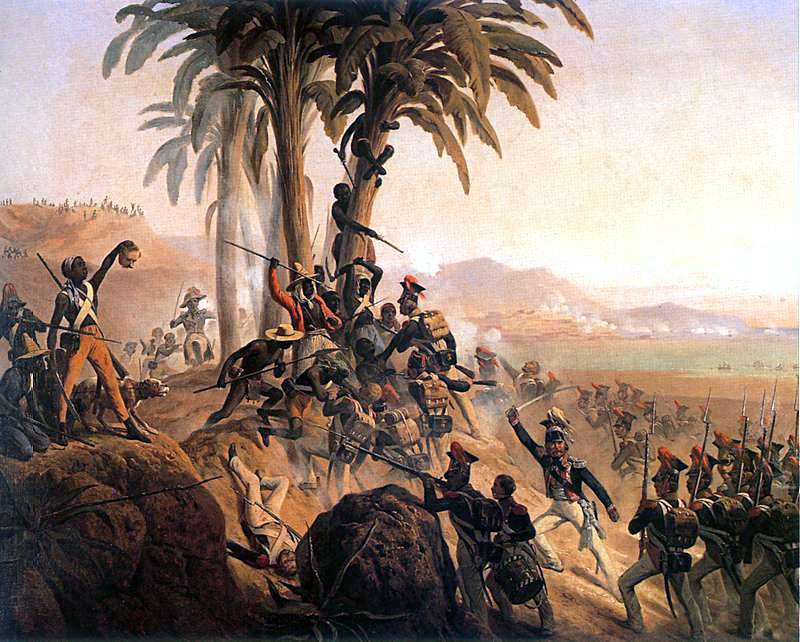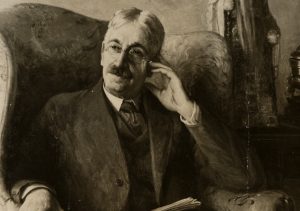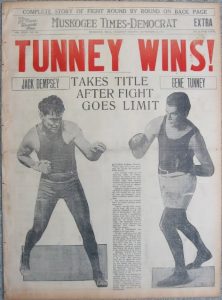The success of the American and the French Revolutions echoed through the people of the new and the old world. These events, powered by the Enlightenment ideas of popular sovereignty, individual freedom, and equality, proved that parting from powerful and oppressive rulers was possible.1 For the first time in recent history, the common man had united and fought for a republic based on the idea and practice of self-rule. This idea of fighting and revolting for independence traveled to slaves on the shores of a Caribbean island where the French had established the colony of Saint-Domingue in 1697.

Saint-Domingue was perhaps one of the most profitable lands that France had in its possession since it produced and exported coffee, indigo, tobacco, cotton, and sugar. The original aboriginal population of the islands had all but disappeared by the time the French had come to the island, and to make use of the colony, the French began to import slaves from Africa to work the fields. It is estimated that by 1789, the colony had a total of 500,000 African slaves, 35,000 white French settlers, and 50,000 colored freedmen who were French citizens and who also owned slaves.2 Despite slaves being the majority of the colony’s population, they lived under a strict and abusive social structure where they worked strenuous jobs under the threat of the whip, and would often starve to death. If runaway slaves were caught, they were often tortured and mutilated in order to dissuade other slaves that there was no escape from the chains of slavery. The daily life for the slaves of Saint-Domingue was one of fear and ill treatment.

French King Louis XIV established the “Code Noir” or Black Codes for the colony, which established rules for the treatment of slaves in all of its French American colonies. The code stated that slave owners were prohibited from sexually violating slaves or from torturing them, and they were required to provide food and clothes to the slaves. Nevertheless, slaves were regarded as property and could receive the death penalty if they did not comply with their masters.3
In 1788, fourteen slaves complained to the court that Nicolas Lejuene, a slave master’s son, would burn slaves alive, and although these acts were clearly violating the law, the courts and public opinion on the Island dismissed Lejuene and he was not prosecuted.4 This incident suggests that laws were not uniformly enforced in the colony, so masters had a free hand in their often atrocious treatments of their slaves. Many slaves ran away from their oppressive masters and hid in the mountains forming large communities of maroons. Their resentment to their French masters only escalated.5

With the ideas of political independence and social revolution circulating the world, slaves in the colony of Saint-Domingue were no longer willing to endure the treatment of their French masters. Tensions in the colony led to a violent uprising. The Haitian Revolution began in August 1791, when about 15,000 slaves destroyed and burned plantations and homes, and murdered white settlers in what was called the “Night of Fire.”6 This event encouraged the educated Catholic and former slave Toussaint L’Ouverture to join the cause. He helped train an army of 50,000 slaves in guerrilla warfare.7 The colony fell into chaos for years as the slaves revolted against French oppression in violent measures, and it was not long before the colony of Saint-Domingue was controlled by the slaves of the island.8

General L’Ouverture allied with the British in order to drive out the French settlers. But unwilling to let go of their colonial power, the French emancipated slaves in 1794; but they were still unable to secure and control the Haitian revolt. By 1803, L’Ouverture had proclaimed himself the governor of the colony, angering the powerful Napoleon Bonaparte who went after L’Ouverture, capturing and imprisoning him. This, however, did not weaken the resolve of the slaves to form an independent state. As Jean-Jacques Dessalines rose to power in the absence of Toussaint L’Ouverture, he ordered the gruesome execution of all Frenchmen in the colony. A year later, in 1804, Haiti was declared independent from French power.9
The slaves of Saint-Domingue were not expected to take on the example of the American colonies and the Enlightenment Era in order to fight for their independence. After the gory and terrible deaths of almost half the population in the colony–including French settlers, free black men and slaves–Haiti stood tall and free, shocking the world.10
- Jerry H. Bentley, Herbert F. Ziegler and Heather E. Streets-Salter, Traditions and Encounters: A Brief Global History Vol 2 (New York: MacGraw-Hill Education, 2016), 471. ↵
- Encyclopedia of Emancipation and Abolition in the Transatlantic World, 2007, s.v. “Haitian Revolution,” by Eugenio Matibag and Junius Rodriguez. ↵
- Philippe R. Girard, “Code Noir,” in Africa and the Americas: Culture, Politics, and History, no.1 (2008): 1. ↵
- Laurie M. Wood, “Across Oceans and Revolutions: Law and Slavery in French Saint-Domingue and Beyond,” Law & Social Inquiry 39, no. 3 (Summer 2014): 5. ↵
- Jerry H. Bentley, Herbert F. Ziegler and Heather E. Streets-Salter, Traditions and Encounters: A Brief Global History Vol 2 (New York: McGraw-Hill Education, 2016), 478-479. ↵
- The Black Past: Remembered and Reclaimed, 2007, s.v. “L’Ouverture Toussaint (1742-1803),” by Deborah McNally. ↵
- J. R. Beard, The Life of Toussaint L’Ouverture, the Negro Patriot of Hayti: Comprising an Account of the Struggle for Liberty in the Island, and a Sketch of Its History to the Present Period (Chapel Hill: University of North Carolina at Chapel Hill Library, 2012), 54. ↵
- Matt Clavin, “Race, Rebellion, and the Gothic: Inventing the Haitian Revolution,” Early American Studies, no. 1 (2007): 5. ↵
- Matt Clavin, “Race, Rebellion, and the Gothic: Inventing the Haitian Revolution.” Early American Studies, no. 1 (2007): 2. ↵
- Matt Clavin “Race, Rebellion, and the Gothic: Inventing the Haitian Revolution.” Early American Studies, no. 1 (2007): 5. ↵



70 comments
Hailey Koch
I wanted to start off by saying you did a great job on your article I really enjoyed reading it and learning new things. I had no idea Saint-Domingue was the most successful in all of France in the time period of the late 1600s and the early 1700s. Saint-Domingue was known for tobacco, sugar, cotton, coffee, and indigo. Since they were so successful with these things they had to bring slaves over from Africa to help work in their fields since they needed more help. Since they brought over a lot of slaves, they ended up making most of the colonies’ population over everyone else.
Kristen Leary
What a great story! With the large portion of the population being enslaved, it is no wonder they were able to rise up and defeat the settlers who were their masters. It is interesting how the French crown established a code of ethics for the treatment of slaves, but very unfortunate that it made little difference in practice. I’m glad to have read this article.
Lauren Deleon
I am currently taking a Cuban History course in which we talk a lot about how the Haitian Revolution effected Cuba, which also had a very high slave population. Many of the French planters actually found refuge in Cuba and brought the stories of the slave revolt with them. This created a fear that Cuba would be the next to fall to an African uprising and created a lot of paranoia amongst the white planters. What I did not know is that L’Ouverture received aid from the English so thank you for including that information.
Sofia Perez
Hi Ana, nice article! Of all the slave revolts that happened throughout history, the revolt of Haiti was the only successful revolt. Many slaves during this time would die due to getting beaten, tortured, starved, or from illness. I found it interesting to read about the Black Codes as they gave the slaves some sort of protection; however, if the slaves did not obey their masters then they could receive the death penalty.
Jaedon E
Interesting article!! I love how descriptive and informational it was about how the slave revolt was influenced of how inequality slaves were being treated. It is sad though how the “black Codes” were established and not formally and uniformly enforced allowing slave owners to completely abuse and unethically treat their slaves. What I did like though was how former slave Toussaint L’Ouverture to join the cause and build a army to force a change from the French. Overall great article.
Priscilla Leal
Its definitely interesting to see how every country treated slaves and how France had laws on how to treat them. Its disappointing to see that France didnt enforce those laws more within their colonies and how much the colonies were able to get away with. The revolt of Haiti was good turning point in history for France, and I like how this article told its history.
Nicholas Quintero
this article was an amazing one! the structure of breaking up paragraphs and each having crucial information made this flow great. this along with the use of imagery that was used in the introduction paragraph and images throughout the article made it super interesting and easy to follow along.
Ki' Asya Jackson
Overall, I enjoyed reading this article. I had knowledge of the fact that slavery existed, but I didn’t know that it pretty much formed Haiti. It was a powerful stance for the slaves to react and try to gain some sort of independence from the strict rule and I like that of all those who revolted, these people came out victorious for their freedom.
Vianne Beltran
Hi Ana,
While the Haitian revolt was discussed briefly in my history class your article gave me lots of new information. I had never heard of “Code Noir.” From a logical standpoint it seems strange that slave owners would not wish to take care of their slaves. If they were considered property, why would someone want to destroy their own items? I guess cruelty is to be expected unfortunately when someone thinks they can own another person.
Grace Malacara
I have briefly learned about the Haitian Revolution in previous classes, and after reading your article I have a clearer understanding. I like that your article is very straight to the point while still bringing the event to life. It was disappointing but not surprising to read about the “Code Noir” and how it was hardly enforced within the colony. Overall great article!